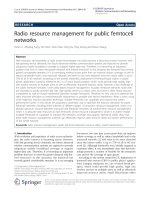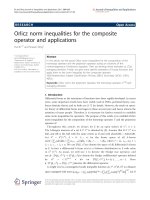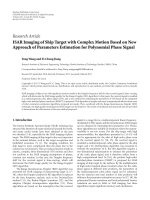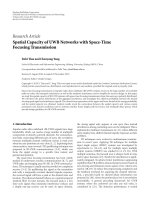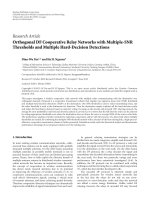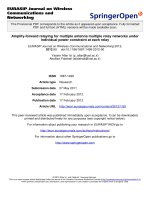Báo cáo hóa học: " Intersymbol Decorrelating Detector for Asynchronous CDMA Networks with Multipath" ppt
Bạn đang xem bản rút gọn của tài liệu. Xem và tải ngay bản đầy đủ của tài liệu tại đây (616.42 KB, 7 trang )
EURASIP Journal on Wireless Communications and Networking 2005:3, 419–425
c
2005 Gaonan Zhang et al.
Intersymbol Decorrelating Detector for Asynchronous
CDMA Networks with Multipath
Gaonan Zhang
School of Electrical and Electronic Engineering, Nanyang Technological University, Block S1, Singapore 639798
Email:
Guoan Bi
School of Electrical and Electronic Engineering, Nanyang Technological University, Block S1, Singapore 639798
Email:
Qian Yu
School of Electrical and Electronic Engineering, Nanyang Technological University, Block S1, Singapore 639798
Received 16 June 2003; Revised 16 March 2005; Recommended for Publication by Lawrence Yeung
Most reported multiuser detection techniques for CDMA systems need the channel estimation including the delay spread and the
parameters of the multipath channel of the desired user. This paper proposes an intersymbol decorrelating detector that makes
use of the cross-correlation matrix constructed by the consecutively received symbols. The proposed detector is attractive for its
simplicity because no channel estimation is required except for the synchronization of the desired user. Compared with other
reported multiuser detectors, simulation results show that the proposed detector provides a good performance when the active
users have significant intersymbol interference.
Keywords and phrases: blind multiuser detection, cross-correlation matrix, multipath, decorrelating detector.
1. INTRODUCTION
Blind multiuser detection for code-division multiple-access
(CDMA) systems has flourished rapidly in recent years. The
general ground work of blind multiuser detection was first
reported i n [1], in which it was assumed that the detector
had no priori knowledge except for the signature waveform
and timing of the desired user. Without considering the mul-
tipath, a blind minimum output energy (MOE) detector was
proposed in [1], and later the canonical subspace representa-
tion of decorrelating detector and minimum mean square er-
ror (MMSE) detector were reported in [2]. In [3], a reduced-
rank MOE detector was proposed by using ar ray processing
techniques. However, these detectors would not work prop-
erly when the intersymbol interference (ISI) could not be ig-
nored. In asynchronous CDMA systems, the ISI is generated
by the delays and the multipath channels of the active users.
In order to overcome the influence of the ISI, several ap-
proaches for channel estimation were developed in [4, 5, 6],
This is an open access article distributed under the Creative Commons
Attribution License, which permits unrestricted use, distr ibution, and
reproduction in any medium, provided the original work is properly cited.
and a number of improved subspace detectors were proposed
by exploiting the channel estimation in [7, 8, 9]. Since the
channel estimation increases the computational complexity
of the detectors substantively, a reduced computational con-
strained optimization solution was proposed with a sacri-
fice of the performance (inferior to MMSE detector) [10].
However, all these methods need to estimate the delay spread
and the parameters of the multipath channel of the desired
user. Hence, one possible drawback for these methods is that
the channel estimation may suffer from variations of chan-
nel and noise environment, which definitely deteriorates the
performance of the detection.
Attempt is reported in this paper to avoid channel esti-
mation based on a new multiuser detection scheme to exploit
the intersymbol information, which has not been considered
in the previously reported detectors. It is noted that in asyn-
chronous CDMA systems, the current received signal has cer-
tain correlation with its preceeding and succeeding ones due
to the existence of ISI and MAI. This paper presents an inter-
symbol decorrelating detector for asynchronous CDMA sys-
tems with multipath. The basic idea of the proposed detec-
tor is to construc t an intersymbol cross-correlation matrix
of the consecutively received symbols, and then to derive the
420 EURASIP Journal on Wireless Communications and Networking
decorrelating detector [11] for the desired user. It is shown
that the proposed detector can be implemented conveniently
without the estimation of the delay spread and the multipath
channel of the desired user. Simulation results show that the
proposed detector achieves a promising performance espe-
cially when the active users have significant intersymbol in-
terference.
The paper is organized as follows. In the next section, sig-
nal model is presented to express asynchronous CDMA sys-
tem in fading multipath channels. By constructing the cross-
correlation matrix, Section 3 develops an intersymbol decor-
relating detector. In Section 4, simulation examples are pro-
vided to demonstrate the performance of the proposed de-
tector. Conclusions are given in Section 5.
2. SIGNAL MODEL
We consider a DS-CDMA system with K users and a normal-
ized spreading factor of N chips p er symbol. The transmitted
signal due to the kth user is given by
y
k
(t) = A
k
∞
i=−∞
b
k
[i]s
k
(t − iT), (1)
where T is the symbol duration, A
k
and b
k
[i] ∈{+1, −1} are,
respectively, the amplitude and the symbol stream of the kth
user. The signature waveform s
k
(t) is of the form
s
k
(t) =
N−1
j=0
c
k
[ j]ψ
t − jT
c
,0≤ t ≤ T,(2)
where c
k
[ j] =±1(0 ≤ j ≤ N − 1) is the spreading se-
quence allocated to the kth user and ψ(t) is the normalized
chip waveform with a duration T
c
= T/N. The discrete-time
expression of the transmitted signal of user k at the chip rate
is obtained by a multirate convolution
y
k
(n) =
∞
i=−∞
b
k
(i)
¯
c
k
(n − iN), (3)
where
¯
c
k
(n) = A
k
c
k
(n)forn = 0, , N − 1. By propagating
through the asynchronous multipath channel that is assumed
to have a maximum length of M (M<N), the received sig-
nal due to user k can be expressed by [12]
r
k
(n) =
∞
m=−∞
y
k
(m)g
k
n − d
k
− m
,(4)
where g
k
(m) = 0, 0 ≤ m ≤ M, is the mth complex multipath
parameter for user k and 0 ≤ d
k
<Nis the delay of user k in
terms of the chip duration. Based on (3)and(4), we obtain
r
k
(n) =
∞
m=−∞
b
k
(m)h
k
n − d
k
− mN
,(5)
where
h
k
(n) =
∞
j=−∞
¯
c
k
( j)g
k
(n − j). (6)
Then, the received signal is the superposition of the signals
from all K users plus additive complex white Gaussian noise,
that is,
r(n) =
K
k=1
r
k
(n)+v(n), (7)
where v(n) is a zero-mean complex Gaussian variable with
a variance of σ
2
.From(6) and denoting h
k,all
= [h
k
(0),
h
k
(1), , h
k
(N − 1+M)]
H
as the signature vector of user
k,weobtain
h
k,all=
¯
C
k
g
k
,(8)
where
¯
C
k
=
¯
c
k
(0) 0
.
.
.
.
.
.
¯
c
k
(0)
¯
c
k
(N − 1)
.
.
.
.
.
.
0
.
.
.
¯
c
k
(N − 1)
, g
k
=
g
k
(0)
.
.
.
g
k
(M)
;
(9)
g
k
is the kth user’s multipath channel vector. According to
(5), we denote
r
k
(n) =
r
k
(nN)
.
.
.
r
k
(nN + N − 1)
, h
k
=
0
h
k
(0)
.
.
.
h
k
N − d
k
− 1
,
(10)
¯
h
k
=
h
k
N − d
k
.
.
.
h
k
(N + M − 1)
0
. (11)
The nth received symbol vector for user k can be given by
r
k
(n) = h
k
b
k
(n)+
¯
h
k
b
k
(n − 1),
(12)
and r(n) = [r(nN), , r(nN + N − 1)]
T
, which is the vector
of the received symbols from all users, is given by
r(n) =
K
k=1
r
k
(n)+v(n) = Hb(n)+v(n), (13)
where H = [h
1
, , h
K
,
¯
h
1
, ,
¯
h
K
] is the signature ma-
trix of all users with full column rank 2K, b(n) =
[b
1
(n), , b
K
(n), b
1
(n − 1), , b
K
(n − 1)]
T
contains the re-
ceived bits of K users, and v(n) = [v(nN), , v(nN + N −
1)]
T
is the independent white Gaussian noise vector.
Intersymbol De tector for CDMA Networks 421
3. INTERSYMBOL DECORRELATING DETECTOR
We assume without loss of generality that user 1 is the desired
user, and that the receiver is synchronized to user 1, that is,
d
1
= 0. Then, the signal in (13)canbewrittenas
r(n) = h
1
b
1
(n)+
¯
h
1
b
1
(n − 1) +
H
˜
b(n)+v(n), (14)
where
H = [h
2
, , h
K
,
¯
h
2
, ,
¯
h
K
]and
˜
b(n) = [b
2
(n), ,
b
K
(n), b
2
(n − 1), , b
K
(n − 1)]
T
are, respectively, the sig-
nature matrix and the received bits of the interfering users.
It is noted from (14) that only the first M entries of
¯
h
1
are
nonzero. Thus, the ISI caused by
¯
h
1
can be removed by trun-
cating the first G ≥ M entries of r(n). For convenience and
without loss of generality, it is assumed that G ≥ M to obtain
r(n) = h
1
b
1
(n)+
H
˜
b(n)+v(n),
(15)
where r(n)isan(N − G) × 1 vector which consists of the last
N − G entries of r(n). Similarly, h
1
,
H,andv(n)arecom-
posed of the last N − G rows of h
1
,
H,andv( n), respectively.
It is assumed throughout the paper that [h
1
H]isoffullcol-
umn rank. The signal in (15) is a truncation of the signal in
(14) which indicates that the ISI of the desired user is elimi-
nated. In the following analysis, G is selected as a fixed num-
ber which is assumed to be not smaller than M. It should be
pointed out that when the selected G is not smaller than M,
the ISI of the desired user in (15) cannot be totally removed.
In this case, the performance of the proposed detector will
suffer deterioration. The influence of the selection of G on
the detector will be simulated and analyzed in Section 4.
In (15), the ISI of the interfering users still exist as their
nonzero delays. This is an advantageous property for the fol-
lowing proposed intersymbol cross-correlation mat rix.
Based on the signal model of (15),alineardetectorfor
user 1 can be represented by a vector w
1
, which is applied to
the received signal r(n). Then, the nth bit of user 1 can b e
estimated according to the following rule:
b
1
[n] = sgn
w
H
1
r(n)
. (16)
In this paper, a linear decorrelating detector is developed
to utilize the intersymbol information of (15). We first con-
struct the autocorrelation matrix of the received signal r(n),
which is g iven by
R = E
r(n)r(n)
H
= h
1
h
H
1
+
H
H
H
+ σ
2
I
N−G
, (17)
where I
N−G
is an (N − G) × (N − G) unitary matrix. A useful
cross-correlation matrix of the received signal r(n)iscon-
structed to obtain the intersymbol information, that is,
¯
R = E
r(n)r(n +1)
H
+ E
r(n)r(n − 1)
H
=
H
0I
K−1
I
K−1
0
H
H
.
(18)
In (18),
¯
R is made up of the cross-correlation of the consec-
utively received signals. It is noted that
¯
R only contains the
signature matrix of all interfering users except for the desired
user because the ISI of the desired user has been truncated in
(15). By performing an eigendecomposition of the matrix R
and
¯
R,weobtain
R =
U
s
, U
n
Λ
s
Λ
n
U
s
, U
n
H
= U
s
Λ
s
U
H
s
+ U
n
Λ
n
U
H
n
,
(19)
¯
R =
¯
U
s
,
¯
U
n
¯
Λ
s
0
¯
U
s
,
¯
U
n
H
=
¯
U
s
¯
Λ
s
¯
U
H
s
,
(20)
where Λ
s
= diag(λ
1
, , λ
2K−1
) contains (2K − 1) largest
eigenvalues of the signal subspace in R,andU
s
contains
the corresponding orthonormal eigenvectors. Both Λ
n
=
σ
2
I
N−G−2K+1
and U
n
are, respectively, eigenvalues and or-
thonormal eigenvectors of the noise subspace. Similarly,
¯
Λ
s
=
diag(
¯
λ
1
, ,
¯
λ
2K−2
) contains (2K − 2) nonzero eigenvalues
and
¯
U
s
contains the corresponding eigenvectors. Obviously,
¯
R contains ISI and MAI of all interfering users.
The construction of
¯
R plays a key role for the following
derived decorrelating detector. Since
¯
R is formed from the
cross-correlation matrix of consecutively received signals, the
proposed detector is then named as intersymbol decorrelat-
ing detector.
We consider the relationship between the subspace
spanned by
¯
R and the subspace spanned by
H.
Proposition 1. The null space of
¯
U
s
in (20) is equal to the null
space of
H in (15),thatis,
null(
H) = null(
¯
U
s
) = range
I
N−G
−
¯
U
s
¯
U
H
s
. (21)
For the proof, see Appendix A.
Proposition 1 shows that I
N−G
−
¯
U
s
¯
U
H
s
projects any signal
onto the null space of
H. Since
H only contains the signature
vectors of interfering users, it is natural to explore the opti-
mal linear detector by removing the influence generated by
H.In[2], the decorrelating detector for user 1 is defined as
the unique signal d ∈ range(U
s
), such that d
H
h
1
> 0and
d
H
H = 0,whereU
s
is given by (19). Clearly, the decorre-
lating detector for user 1 is orthonormal to
H. Then, con-
sidering the property of Proposition 1, another form of the
decorrelating detector is proposed for the desired user, which
is given by the following proposition
Proposition 2. In terms of the matrix
¯
R in (18),thedecorre-
lating detector for user 1 in (15) can be given by
d
1
=
I
N−G
−
¯
U
s
¯
U
H
s
h
1
. (22)
For the proof, see Appendix B.
422 EURASIP Journal on Wireless Communications and Networking
Proposition 2 shows that d
1
is equivalent to the decorre-
lating detector for the desired user.
We now consider the blind implementation of d
1
. Utiliz-
ing the property of Proposition 1,(15) is directly projected
onto I
N−G
−
¯
U
s
¯
U
H
s
to obtain
˜
r(n) =
I
N−G
−
¯
U
s
¯
U
H
s
r(n)
=
I
N−G
−
¯
U
s
¯
U
H
s
h
1
b
1
(n)+
H
˜
b(n)+v(n)
=
I
N−G
−
¯
U
s
¯
U
H
s
h
1
b
1
(n)+v(n)
,
(23)
where the third equality follows from Proposition 1, that is,
(I
N−G
−
¯
U
s
¯
U
H
s
)
H = 0. It is clear from (23) that the MAI and
ISI of all interfering users are removed from
˜
r(n). The auto-
correlation matrix of
˜
r(n)canbegivenby
˜
R = E
˜
r(n)
˜
r
H
(n)
=
I
N−G
−
¯
U
s
¯
U
H
s
h
1
h
H
1
+ σ
2
I
N−G
I
N−G
−
¯
U
s
¯
U
H
s
=
I
N−G
−
¯
U
s
¯
U
H
s
h
1
h
H
1
I
N−G
−
¯
U
s
¯
U
H
s
+ σ
2
I
N−G
−
¯
U
s
¯
U
H
s
.
(24)
We next premultiply d
1
by
˜
R to obtain
˜
Rd
1
=
˜
R
I
N−G
−
¯
U
s
¯
U
H
s
h
1
=
I
N−G
−
¯
U
s
¯
U
H
s
h
1
h
H
1
I
N−G
−
¯
U
s
¯
U
H
s
+ σ
2
I
N−G
−
¯
U
s
¯
U
H
s
I
N−G
−
¯
U
s
¯
U
H
s
h
1
=
h
H
1
I
N−G
−
¯
U
s
¯
U
H
s
h
1
+ σ
2
I
N−G
−
¯
U
s
¯
U
H
s
h
1
.
(25)
Clearly, the decorrelating detector of the desired user d
1
,
that is (I
N−G
−
¯
U
s
¯
U
H
s
)h
1
, is an eigenvector of
˜
R with the
corresponding eigenvalue h
H
1
(I
N−G
−
¯
U
s
¯
U
H
s
)h
1
+ σ
2
.Infact,
h
H
1
(I
N−G
−
¯
U
s
¯
U
H
s
)h
1
+ σ
2
is the largest eigenvalue of
˜
R.Inor-
der to prove this, we consider the rest of the eigenvectors of
˜
R. Denoting u as an eigenvector of
˜
R which is or thogonal to
d
1
, that is u
H
(I
N−G
−
¯
U
s
¯
U
H
s
)h
1
= 0, we have
˜
Ru =
I
N−G
−
¯
U
s
¯
U
H
s
h
1
h
H
1
I
N−G
−
¯
U
s
¯
U
H
s
+ σ
2
I
N−G
−
¯
U
s
¯
U
H
s
u
= σ
2
I
N−G
−
¯
U
s
¯
U
H
s
u,
(26)
where the second equality follows from u
H
(I
N−G
−
¯
U
s
¯
U
H
s
)h
1
= 0. It is clear from (26) that h
H
1
(I
N−G
−
¯
U
s
¯
U
H
s
)h
1
+
σ
2
is the largest eigenvalue of
˜
R, and all of the other eigenval-
ues of
˜
R are smaller than σ
2
. Therefore, the proposed detector
d
1
can b e implemented by calculating the principle eigenvec-
tor of
˜
R, that is,
d
1
=
I
N−G
−
¯
U
s
¯
U
H
s
h
1
= arg max
˜
R
= arg max
I
N−G
−
¯
U
s
¯
U
H
s
R
I
N−G
−
¯
U
s
¯
U
H
s
.
(27)
Algorithm 1 summarizes the implementation of the pro-
posed intersymbol decorrelating detector. It is observed from
Algorithm 1 that the realization of the detector is very simple.
Sampling frame: r(0), r (1), , r(P).
Step 1. Compute autocorrelation and cross-correlation:
R =
1
P +1
P
n=0
r(n)r(n)
H
,
¯
R =
1
P
P
n=0
r(n − 1)r(n)
H
+
P
n=1
r(n)r(n − 1)
H
.
Step 2. Compute eigendecomposition of
¯
R:
¯
R = [
¯
U
s
,
¯
U
n
]
¯
Λ
s
0
[
¯
U
s
,
¯
U
n
]
H
=
¯
U
s
¯
Λ
s
¯
U
H
s
.
Step 3. Form decorrelating detector:
d
1
= Max-eigen vector (I
N−G
−
¯
U
s
¯
U
H
s
)R(I
N−G
−
¯
U
s
¯
U
H
s
).
Algorithm 1: Blind intersymbol decorrelating detector.
No information is needed on background noise level, the de-
lay spread, the parameters of the multipath channel, or even
the spreading sequence of the desired user. The only require-
ment is the synchronization of the desired user. In contrast,
some of these parameters must be known or estimated for the
detectors of [7, 8, 12]. It should be pointed out that the basic
idea of the proposed detector is to utilize the eigendecompo-
sition of the cross-correlation matrix
¯
R to null out the ISI and
MAI of all interfering users. According to (15),
¯
R has 2(K −1)
eigenvectors spanned by h
k
¯
h
H
k
+
¯
h
k
h
H
k
for k = 2, , K.How-
ever, if the kth interfering user has similar delays to that of
the desired user, that is, d
k
≈ 0, the eigenvalues correspond-
ing to the kth user in
¯
R will be small since only the first d
k
entries of
¯
h
k
are nonzero. Because it is usually difficult to esti-
mate the small eigenvalue’s subspace accurately, more errors
will occur on the estimation of the kth user’s eigenvectors
in step 2 of Algorithm 1 for small d
k
. In this case, the esti-
mated
¯
U
s
may lose a part of the kth user’s information and
the proposed detector cannot totally null out the interference
of the kth user. Then, the performance of the proposed de-
tector will be deteriorated, which will be shown in the next
section.
Remark 1. Since the proposed detector relies heavily on the
perfect synchronization of the desired user, errors of the syn-
chronization may deteriorate the performance of the pro-
posed detector. However, the synchronization of the desired
user or, equivalently, the available delay information of the
desired user is a basic prerequirement for all linear multiuser
detectors. All of the detectors mentioned in this paper require
the available knowledge of the delay of the desired user, and
the error of the synchronization will definitely deteriorate the
performance of these detectors. In practical CDMA systems
such as CDMA 2000, special synchronization channel is al-
located in order to obtain the precise timing information of
the desired user.
Remark 2. Compared with the conventional subspace decor-
relating detector in [2], the proposed intersymbol decorre-
lating detector has a simpler implementation. By assuming
the synchronization of the desired user, the decorrelating de-
tector in [2] also needs to estimate the multipath channel
response vector of the desired user g
1
and the variance of
Intersymbol De tector for CDMA Networks 423
121086420−2−4
E
b
/N
0
(dB)
10
−1
10
−2
10
−3
10
−4
BER
Proposed (M = 7)
Optimal (M
= 7)
Spatio-temporal (M = 7)
Proposed (M = 5)
Spatio-temporal (M = 5)
Optimal (M = 5)
Spatio-temporal (M = 3)
Proposed (M = 3)
Optimal (M = 3)
Figure 1: BER of various decorrelating detectors: G = 5, K = 8,
d
k
≥ 8(k = 2, ,8).
the background noise σ
2
. However, the channel estimation
will increase the complexit y of the detector and the chan-
nel estimation error will deteriorate the performance of the
detector. Such required channel estimations are removed in
the proposed detector by introducing an intersymbol cross-
correlation matrix
¯
R, which leads to a simpler implementa-
tion. In addition, the proposed method makes an unstr uc-
tured assumption on the received desired waveform. It is
generally true that an estimator under structured assump-
tions performs better than that under unstructured assump-
tions. Since the conventional detectors in [2] use a struc-
tured assumption on the received desired waveform in which
only the multipath coefficients are not known, these detec-
tors normally achieve better performance compared with the
proposed detctor.
4. SIMULATION RESULTS
In this section, experimental results are provided to illus-
trate the performance of the proposed intersymbol decorre-
lating detector. The proposed method is tested in an asyn-
chronous CDMA system with K = 8usersandspread-
ing gain N = 31. The spreading sequences for all users
are generated by Gold codes. For both cases, we simu-
late a severe near-far s ituation that e ach interfering user
is at least with a power of 10 dB more than that of the
desired user. Meanwhile, user 1 is assumed to be syn-
chronized and all interfering users have the delay smaller
than the duration of one symbol. The multipath g a ins in
each user’s channel are randomly chosen and kept fixed.
The multipath gains have been normalized with equal
121086420−2−4
E
b
/N
0
(dB)
10
−1
10
−2
10
−3
10
−4
BER
Proposed (M = 7)
Optimal (M
= 7)
Spatio-temporal (M = 7)
Proposed (M = 5)
Spatio-temporal (M = 5)
Optimal (M = 5)
Spatio-temporal (M = 3)
Proposed (M = 3)
Optimal (M = 3)
Figure 2: BER of various decorrelating detectors: G = 5, K = 8,
d
2
= 3, d
3
= 2, d
k
≥ 8(k = 4, ,8).
power. We compare the performance of three decorrelat-
ing detectors, that is, the optimal decorrelating detector,
the proposed detector, and the spatio-temporal decorrelat-
ing detector in [7]. The proposed detector is implemented
by Algorithm 1, where the length of signal frame is P = 500.
The truncating window of the proposed detector is G = 5,
that is, the first five entries of the received signal vector are
truncated to remove the ISI of the desired user.
Figure 1 compares the performance of these detectors
under different delay spreads of the multipath channel. In
this example, the initial delay d
k
of each interfering user is as-
sumed to be randomly distributed between 8 and 31 in terms
of the chip cycle T
c
, that is, the interfering users have signifi-
cant intersymbol interference. It is seen that the BERs of the
proposed detector are close to the true optimal decorrelating
detector and are always better than that of spatio-temporal
decorrelating detector [7] when the delay spreads of the mul-
tipath channel are 3 and 5. This is because the signal channel
is ideal for the proposed detector, that is, the ISI of the desired
user is totally removed because M ≤ G, and all interfering
users have significant intersymbol interference as the delay
d
k
≥ 8. When the delay spread of the multipath channel in-
creases to 7, the perfor mance of the proposed detector suffers
more deterioration and is close to that of the spatio-temporal
decorrelating detector. The reason for such deterioration is
that the signal in (15) cannot totally remove the ISI of the
desired user in the case of M>G. Hence, the remanent ISI of
the desired user in
¯
R will influence the accuracy of the pro-
posed detector. Figure 2 also compares the performance of
the above detectors with different delay spreads of the multi-
path channel. In this example, two users are assumed to have
similar delays to that of user 1, that is, d
2
= 3andd
3
= 2,
424 EURASIP Journal on Wireless Communications and Networking
while the other five interfering users’ delays are larger than
or equal to 8 T
c
. It is seen that the performances of the opti-
mal detector and the spatio-temporal detector in Figure 2 are
similar to their performances in Figure 1. However, the inter-
fering user’s delay has obvious influence on the performance
of the proposed detector. In Figure 2, the proposed det ector
has higher BERs compared with that in Figure 1. Meanwhile,
the performance of the proposed detector is inferior to that
of the spatio-temporal detector except when the multipath
length M = 3. As explained in the previous section, this is
because the eigenvalues corresponding to user 2 and user 3
in
¯
R are close to zero due to small delays. Thus, more errors
will occur on the estimation of the eigenvectors of user 2 and
user 3 within limited signal fr ame, w hich leads to the deteri-
oration of the proposed detector.
In general, the performance of the proposed detector is
more sensitive to the delays of the interfering users com-
pared with the optimal decorrelating detector and the spatio-
temporal decorrelating detector. However, our method is
very simple and only requires the delay of the desired user,
while the spatio-temporal decorrelating detector in [7]re-
quires the knowledge of the delay, the signature sequence of
the desired user, and the desired user’s multipath channel g
1
.
5. CONCLUSIONS
A blind intersymbol decorrelating detector for asynchronous
CDMA systems is proposed. The detector makes use of an
important cross-correlation matrix between adjacent sym-
bols to mitigate the influence of the interfering users. It is
shown that the detector can be easily implemented without
the estimations of the multipath channel and the multipath
length, while a good performance is achieved when the sys-
tem has significant intersymbol interference.
APPENDICES
A. PROOF OF PROPOSITION 1
Denote an (N
−G)×1vectorbyx. The proof of Proposition 1
is equivalent to the proof of the following items:
(1) if x
H
H = 0, this implies x
H
¯
U
s
= 0,
(2) if x
H
¯
U
s
= 0, this implies x
H
H = 0.
We consider
¯
R
¯
R
H
, which is given by
¯
R
¯
R
H
=
H
0I
K−1
I
K−1
0
H
H
H
0I
K−1
I
K−1
0
H
H
=
HW
H
H
=
¯
U
s
¯
Λ
s
¯
U
H
s
¯
U
s
¯
Λ
s
¯
U
H
s
=
¯
U
s
¯
Λ
2
s
¯
U
H
s
,
(A.1)
where
W =
0I
K−1
I
K−1
0
H
H
H
0I
K−1
I
K−1
0
(A.2)
and the third equality follows from (20). Obviously,
¯
R
¯
R
H
is
positive and has the same eigenvectors as that of
¯
R.Toprove
the first item, we have
x
H
H = 0 =⇒ x
H
HW
H
H
x = 0
=⇒ x
H
¯
U
s
¯
Λ
2
s
¯
U
H
s
x = 0
=⇒ x
H
¯
U
s
= 0,
(A.3)
where the last step follows from the fact that
¯
Λ
2
s
is a positive
diagonal matrix. For the second item, the proof is as follows:
x
H
¯
U
s
= 0 =⇒ x
H
¯
U
s
¯
Λ
2
s
¯
U
H
s
x = 0
=⇒ x
H
HW
H
H
x = 0
=⇒ x
H
H = 0.
(A.4)
Similarly, the last step in (A.4)isderivedbecauseW is
also positive and of ful l rank. By using items (1) and (2), we
have (
¯
U
s
) = (
H). In addition, (
¯
U
s
) can be easily expressed by
its projection matrix, that is, (
¯
U
s
) = range(I
N−G
−
¯
U
s
¯
U
H
s
),
where I
N−G
−
¯
U
s
¯
U
H
s
projects any signal onto the null space of
H.
B. PROOF OF PROPOSITION 2
Basedon(15) and the eigendecomposition of (19), the
decorrelating detector for user 1 must satisfy the follow con-
ditions [11]:
d
1
=
I
N−G
−
¯
U
s
¯
U
H
s
h
1
∈ range
U
s
,
d
H
1
h
1
> 0, d
H
1
H = 0.
(B.1)
With (19), the proof of the first condition is equivalent to
the proof of U
H
n
d
1
= 0 since range(U
s
) = (U
n
). It is easily
achieved as follows:
U
H
n
d
1
= U
H
n
I
N−G
−
¯
U
s
¯
U
H
s
h
1
= U
H
n
h
1
− U
H
n
¯
U
s
¯
U
H
s
h
1
= 0,
(B.2)
where the third equality follows from the fact that h
1
∈
range(U
s
) is orthogonal to U
n
, and range(U
n
) = (
H, h
1
)be-
longs to the subspace of (
H) = (
¯
U
s
), that is, U
H
n
¯
U
s
= 0.
Now we consider the second condition. With (20)and
Proposition 1, it is easy to obtain
d
H
1
h
1
= h
H
1
I
N−G
−
¯
U
s
¯
U
H
s
h
1
= h
H
1
¯
U
n
¯
U
H
n
h
1
> 0,
d
H
1
H = h
H
1
I
N−G
−
¯
U
s
¯
U
H
s
H = 0.
(B.3)
Therefore, d
1
is the decorrelating detector of user 1.
Intersymbol De tector for CDMA Networks 425
REFERENCES
[1]M.Honig,U.Madhow,andS.Verd
´
u, “Blind adaptive mul-
tiuser detection,” IEEE Trans. Inform. Theory,vol.41,no.4,
pp. 944–960, 1995.
[2] X. Wang and H. V. Poor, “Blind multiuser detection: a sub-
space approach,” IEEE Trans. Inform. Theory, vol. 44, no. 2,
pp. 677–690, 1998.
[3] J. B. Schodorf and D. B. Williams, “Array processing tech-
niques for multiuser detection,” IEEE Trans. Commun.,
vol. 41, no. 11, pp. 1375–1378, 1997.
[4]A.N.BarbosaandS.L.Milter,“Adaptivedetectionof
DS/CDMA signals in fading channels,” IEEE Trans. Commun.,
vol. 46, no. 1, pp. 115–124, 1998.
[5] H. C. Huang and S. Verd
´
u, “Linear differentially coherent
multiuser detection for multipath channels,” Wireless Personal
Communications, vol. 6, no. 1-2, pp. 113–136, 1998.
[6] X. Wang and H. V. Poor, “Adaptive joint multiuser detection
and channel estimation in multipath fading CDMA chan-
nels,” ACM/Baltzer Wireless Networks, vol. 4, no. 6, pp. 453–
470, 1998.
[7] A. Chkeif, K. Abed-Meraim, G. Kawas-Kaleh, and Y. Hua,
“Spatio-temporal blind adaptive multiuser detection,” IEEE
Trans. Commun., vol. 48, no. 5, pp. 729–732, 2000.
[8] M. Torlak and G. Xu, “Blind multiuser channel estimation in
asynchronous CDMA systems,” IEEE Trans. Signal Processing,
vol. 45, no. 1, pp. 137–147, 1997.
[9] X. Wang and H. V. Poor, “Blind equalization and multiuser
detection in dispersive CDMA channels,” IEEE Trans. Com-
mun., vol. 46, no. 1, pp. 91–103, 1998.
[10] M. K. Tsatsanis and Z. Xu, “Performance analysis of mini-
mum v ariance CDMA receivers,” IEEE Trans. Signal Process-
ing, vol. 46, no. 11, pp. 3014–3022, 1998.
[11] S. Verd
´
u, Multiuser Detection, Cambridge University Press,
Cambridge, UK, 1998.
[12] Z. Xu and M. K. Tsatsanis, “Blind adaptive algorithms for
minimum variance CDMA receivers,” IEEE Trans. Commun.,
vol. 49, no. 1, pp. 180–194, 2001.
Gaonan Zhang received the B.S. degree in
electrical engineering from Xi’an Highway
University, Xi’an, China, in 1995, and the
M.S. degree in system engineering from
Xi’an Jiaotong University, Xi’an, China, in
2000. Starting June 2000, he became a Ph.D.
student in the Division of Information En-
gineering, School of Electrical and Elec-
tronic Engineering, Nanyang Technological
University, Singapore. His research areas in-
clude multiuser detection for CDMA systems and advanced sig-
nal processing for wireless communication. He has served as a re-
searcher in Flextronics Asia Design Pte Ltd, Singapore, from 2003
to 2004. Since 2004, he has been working as a Senior Engineer in
Motorola Design Center, Singapore. His current works include the
design and the development of GSM and 3G CDMA products.
Guoan B i received a B.S. degree in radio
communications from the Dalian Univer-
sity of Technology, China, in 1982, the M.S.
degree in telecommunication systems, and
the Ph.D. degree in electronics systems from
Essex University, UK, in 1985 and 1988, re-
spectively. Since 1991, he has been with the
School of Electr ical and Electronic Engi-
neering, Nanyang Technological University,
Singapore. His current research interests in-
clude DSP algorithms and hardware structures and digital signal
processing for communications.
Qian Yu received the B.S. and M.S. degrees
in control theory and applications in 1997
and 2000, respectively, from the North-
western Polytechnical University (NWPU),
Xi’an, China. She is currently working to-
ward the Ph.D. degree in the Div ision of In-
formation Engineering, School of Electrical
and Electronic Eng ineering, Nanyang Tech-
nology University, Singapore. Her general
research interests are in the area of signal
processing for wireless communication systems.

